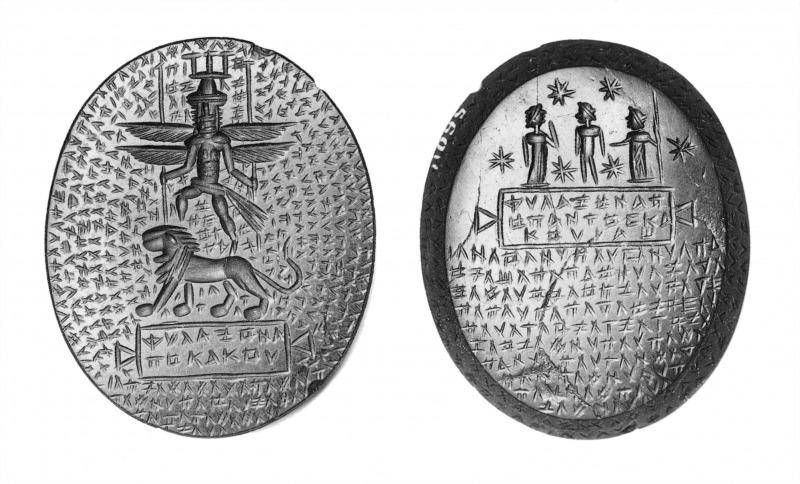Schwartz - Schwartz on CBd-1780
34. Schwartz
a: Composite god standing on back of lion walking l. The god’s body, which is human, is bare-chested, wears kilt, and appears to lie shown from behind. Bird tail to r., two pairs of wings. Two arms below wings hold long vertical scepters. God wears bulbous headdress on top of which is abbreviation of hemhem crown. Four short horizontal lines protrude from each side of head. Lion stands on tabula ansata within which: ΦVΛAΞON AΠO / ΠANTOC KAK/OV TON ΦOP<OVNTA>. Around, covering the entire field of the gem:
L., reading upward
Outer line: IAW?] CABAW MIXAHΛ AHUA
2nd line: CEMECIΛAM COVMAPTA
3rd line: ABΛANAΘANAΛBAC
4th line: A COYMAP<TA>N
5th line: TAANP
6th line:
2nd line: CEMECIΛAM COVMAPTA
3rd line: ABΛANAΘANAΛBAC
4th line: A COYMAP<TA>N
5th line: TAANP
6th line:
R., reading downward
Outer line: AMAPI IAI HIH A
2nd line: PAPAN ΓOOEIPI
3rd line: AKPAMAXAMA<PI>
4th line: COVMAPTA
5th line: ΛCEMEI
6th line: II (or Ọ) CI
2nd line: PAPAN ΓOOEIPI
3rd line: AKPAMAXAMA<PI>
4th line: COVMAPTA
5th line: ΛCEMEI
6th line: II (or Ọ) CI
Outside l. staff: AM
Inside l. staff: IOA
Between legs: NA / IA / KI
Above bird tail: O
Below bird tail: ΛO / WI
Beneath lion: MI I
To l. of tabula ansata: MI
To r. of tabula ansata: IẠ (or Λ)
Below tabula ansata: OVINOIΛNIXI / COVΛXΛMΛOO / ΛIXΛNIV
Inside l. staff: IOA
Between legs: NA / IA / KI
Above bird tail: O
Below bird tail: ΛO / WI
Beneath lion: MI I
To l. of tabula ansata: MI
To r. of tabula ansata: IẠ (or Λ)
Below tabula ansata: OVINOIΛNIXI / COVΛXΛMΛOO / ΛIXΛNIV
Bevel: Three lines of inscription, bases of letters towards side a. CEMECIΛAM Ψ COVMAPTA COVMAPTA AΔWNAI AABAW ABPACAΞ / COYMAPTA .jpg) E
E.jpg)
.jpg) ỴΛMΛCP (cut over E) CEΓ AKPAMAXAMAPI AKPAAE (or Θ) ΨAKPA CΛI / CEMECIΛA{Ψ}M....
ỴΛMΛCP (cut over E) CEΓ AKPAMAXAMAPI AKPAAE (or Θ) ΨAKPA CΛI / CEMECIΛA{Ψ}M.....jpg)
 TẠṆEOYMAPI
TẠṆEOYMAPI.jpg)
 ΛIVNMEN ΓA..CI...ΞIΛΛṾỊỴ
ΛIVNMEN ΓA..CI...ΞIΛΛṾỊỴ
b: Two figures, each holding staff in outer arm, touching central figure; all stand on tabula ansata; to l. and r., eight-pointed stars. Within tabula ansata, ΦVΛAION AΠ/O ΠANTOC KA/KOV TON ΦO<POVNTA> Beneath, IAW CABAW ABPACAΞ A/ΔWNAI COVMAPTA EA / AΨ AKPAMAXAPEI / ΔCE COVMAPTA K / IΛEΛA ΨAKPA CECE/ΓENBAPΦAPANΓ/HC AΔ WNAI ΛAI / COVMAPTA H / IAEA .jpg) IΨCỊ/MEI
IΨCỊ/MEI
Obsidian.
Goodenough 1123. Delatte and Derchain 177, 312.
The Kelsey Museum has an almost identical amulet (Mich. 26070 /CBd-2313/) which is unpublished. There are also four similar gems in the British Museum (BM G10 /CBd-678/, G11 /CBd-676/, G205 /CBd-680/, G385 /CBd-679/).
The inscription in the tabulae ansatae means “protect the bearer from all evil.” The long inscriptions in the fields and on the bevel are unusual for gems of this kind because they contain many recognizable magical words and names.
Almost all of these are Jewish. Scholem has shown convincingly that akramachamarei, sensen barpharanges and possibly ablanathanalba are Aramaic in origin. The origin and meaning of the magic word COVMAPTA, which occurs nine times on this gem, are not known. The word occasionally appears in magical papyri.70
The three figures on side b probably represent Castor and Pollux accompanying a goddess. Chapouthier71 has catalogued examples of this triad, most of which can be dated to the second and third centuries A.D. The identification is sug-gested by the similarity of the two outer figures to depictions of the Dioscuri from this period (see, for example, the Alexandrian bronze drachms of Trajan and Hadrian and a tetra-drachm of Septimius Severus ). As on many of the monuments in Chapouthier's catalogue, the goddess has no recognizable attributes; often, however, several specific goddesses can be identified, most commonly Helen. Others are Selene, Cybele, Hera, Artemis, Hekate, Astarte, Demeter, Nemesis, and Isis. Identification of the group on the gem as Chapouthier’s triad is tentative.
70 Scholem (above, n. 13), pp. 94-100. COVMAPTA also appears in a Greek formula inserted in a mediaeval Latin charm to stop bleeding; see A. A. Barb, “Die Blutsegen von Fulda und London,” in Festschrift für Gerhard Eis (Stuttgart, 1968), p. 488.
71 F. Chapouthier, Les Dioscures au Service d'une Déesse (Paris, 1935), pp. 21-123. If not mounted or leading horses, the Dioscuri are typically shown holding long staves; besides two piloi, two eight-pointed stars are their most common symbol (pp. 105-15). Chapouthier (pp. 335-36) suggests that the function of the triad is protective: the twins and the goddess, “dieux sauveurs,” stand guard and provide assistance. Cumont (above, n. 50), chap. 1, pp. 91-93, has shown that in the Roman period the Dioscuri represented the two revolving halves of the sky, and therefore eternal time. It is thus possible that the central figure is not a goddess, but represents the bearer of the amulet, who is to be guided and protected throughout eternity.
Last modified: 2016-02-24 23:09:27
Link: cbd.mfab.hu/pandecta/1846




